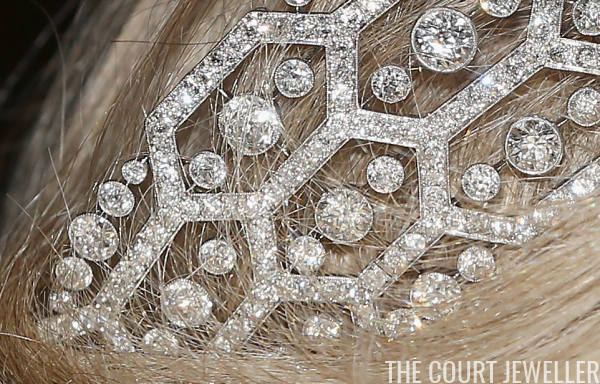 |
| Chris Jackson/Getty Images |
Way back in the days of Mad Hattery, I nicknamed this glittering sparkler “The Mighty Bouch.” It’s easy to see why — the sparkle from this thing packs quite the punch! Most of us used to call it “the Boucheron Honeycomb Tiara,” but in 2012, we learned that the royal family simply calls it “the Greville Tiara.” Either way, it’s impressive — and even more so when you view it close up!
 |
| The Queen Mother wears the Greville Tiara with the Greville Peardrop Earrings and Queen Alexandra’s Wedding Necklace in November 1964; eagle-eyed readers will spot Princess Marina standing behind her, wearing her Russian Pearl Bandeau (Michael Stroud/Express/Getty Images) |
The Queen Mother received the tiara in 1942 when the Hon. Mrs. Greville bequeathed her all of her jewelry. The diamond and platinum tiara was made for Mrs. Greville in 1921 by Lucien Hirtz, the chief designer for Boucheron in Paris. Clever Mrs. Greville saved money on the new diadem by having another, older Boucheron tiara from her collection broken up so that the diamonds could be reused in the creation of this more modern tiara. The tiara became one of the Queen Mother’s favorite jewels; she wore it throughout her life, and eventually bequeathed it to her daughter, the Queen, in 2002. The Queen has never worn this tiara in public.
 |
| The Duchess of Cornwall wears the Greville Tiara with her diamond floral and pearl drop earrings, plus one of her pearl chokers with a diamond clasp, at the State Opening of Parliament in May 2016 (Dan Kitwood/Getty Images) |
When the Duchess of Cornwall married the Prince of Wales in 2005, the Queen loaned her the Greville on a long-term basis. It’s now become her signature tiara, and her many appearances in the sparkler have given us some excellent close-up views of the piece.
 |
| Chris Jackson/Getty Images |
This view of the center portion of the tiara emphasizes the honeycomb design of the tiara itself, as well as the round diamonds set within the honeycomb sections. The millegrain treatment (that’s the little “dots” on the metal) on the platinum setting makes the stones appear even sparkler. And I’m always in awe of the pave-set diamonds in the honeycomb portion — it’s done so well that, even in extreme close-up, it’s sometimes difficult to pick out the individual diamonds.
 |
| Chris Jackson/Getty Images |
When the Queen Mum received the tiara in 1942, the top of the piece was much flatter. Rather than the raised sections you see today, rows of five graduated diamonds were situated between the honeycombs at the top of the tiara, giving the piece a more kokoshnik-like shape. Some of these original diamond settings survive on each side of the tiara today, as you can see at the left in the image above.
 |
| Chris Jackson/Getty Images |
In 1953, the Queen Mother turned to Cartier to reconfigure five diamond sections at the center of the top of the tiara. They shifted the original diamonds (which you can identify thanks to their millegrain settings) from a graduated line to a more triangular shape. Five diamonds were also added to the tiara: four round brilliants, which were taken from a dismantled brooch, and a single marquise diamond at the tiara’s apex.
 |
| Chris Jackson/Getty Images |
Here’s a close-up look of the marquise in the center of the tiara. See the difference in the settings? Cartier didn’t replicate Boucheron’s original millegrain technique in their work. The additions and changes, though relatively subtle, definitely impacted the profile of the tiara, adding height and taking away that curved, kokoshnik shape.
 |
| Chris Jackson/Getty Images |
To accomplish the curving shape of the diadem, you’ll note that there are breaks in some of the hexagonal honeycomb elements, allowing the tiara a slight articulation so that it can curve around the tiara frame.
 |
| Chris Jackson/Getty Images |
And here’s a look at the base of the tiara; the thin wire base is currently padded with blonde-colored velvet to match the Duchess of Cornwall’s head. Photographs of the piece from Sir Hugh Roberts’s book show the base of the tiara without the velvet wrapping. (It’s on page 241, for those who want to check their jewelry libraries!)
Leave a Reply